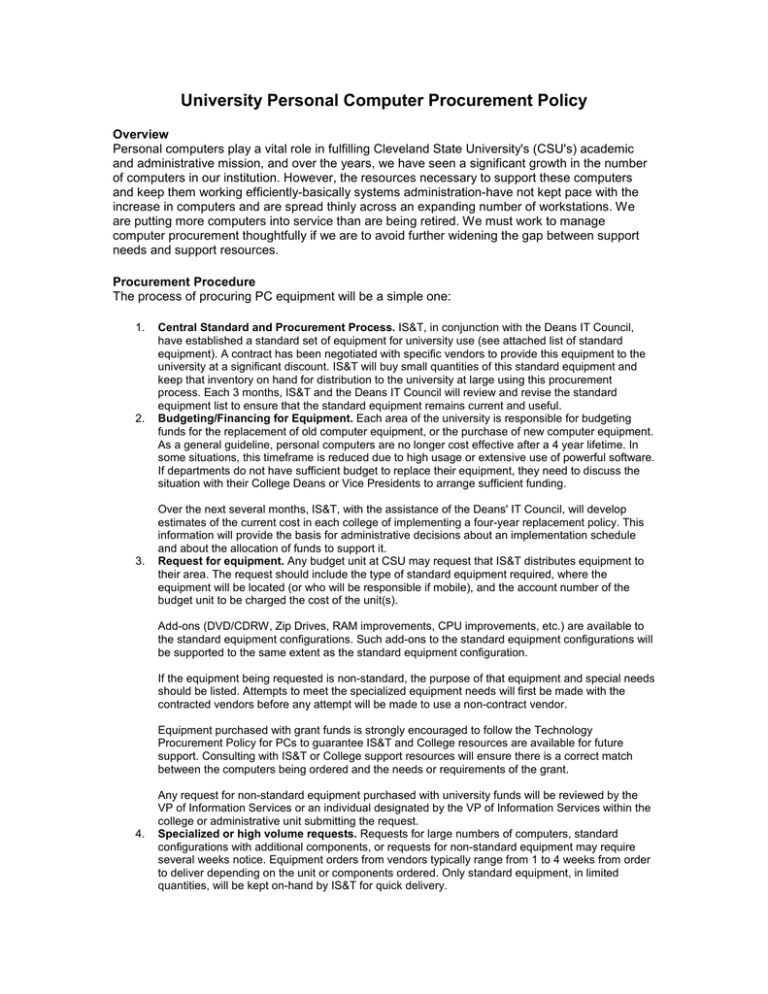University Personal Computer Procurement Policy
advertisement

University Personal Computer Procurement Policy Overview Personal computers play a vital role in fulfilling Cleveland State University's (CSU's) academic and administrative mission, and over the years, we have seen a significant growth in the number of computers in our institution. However, the resources necessary to support these computers and keep them working efficiently-basically systems administration-have not kept pace with the increase in computers and are spread thinly across an expanding number of workstations. We are putting more computers into service than are being retired. We must work to manage computer procurement thoughtfully if we are to avoid further widening the gap between support needs and support resources. Procurement Procedure The process of procuring PC equipment will be a simple one: 1. 2. 3. Central Standard and Procurement Process. IS&T, in conjunction with the Deans IT Council, have established a standard set of equipment for university use (see attached list of standard equipment). A contract has been negotiated with specific vendors to provide this equipment to the university at a significant discount. IS&T will buy small quantities of this standard equipment and keep that inventory on hand for distribution to the university at large using this procurement process. Each 3 months, IS&T and the Deans IT Council will review and revise the standard equipment list to ensure that the standard equipment remains current and useful. Budgeting/Financing for Equipment. Each area of the university is responsible for budgeting funds for the replacement of old computer equipment, or the purchase of new computer equipment. As a general guideline, personal computers are no longer cost effective after a 4 year lifetime. In some situations, this timeframe is reduced due to high usage or extensive use of powerful software. If departments do not have sufficient budget to replace their equipment, they need to discuss the situation with their College Deans or Vice Presidents to arrange sufficient funding. Over the next several months, IS&T, with the assistance of the Deans' IT Council, will develop estimates of the current cost in each college of implementing a four-year replacement policy. This information will provide the basis for administrative decisions about an implementation schedule and about the allocation of funds to support it. Request for equipment. Any budget unit at CSU may request that IS&T distributes equipment to their area. The request should include the type of standard equipment required, where the equipment will be located (or who will be responsible if mobile), and the account number of the budget unit to be charged the cost of the unit(s). Add-ons (DVD/CDRW, Zip Drives, RAM improvements, CPU improvements, etc.) are available to the standard equipment configurations. Such add-ons to the standard equipment configurations will be supported to the same extent as the standard equipment configuration. If the equipment being requested is non-standard, the purpose of that equipment and special needs should be listed. Attempts to meet the specialized equipment needs will first be made with the contracted vendors before any attempt will be made to use a non-contract vendor. Equipment purchased with grant funds is strongly encouraged to follow the Technology Procurement Policy for PCs to guarantee IS&T and College resources are available for future support. Consulting with IS&T or College support resources will ensure there is a correct match between the computers being ordered and the needs or requirements of the grant. 4. Any request for non-standard equipment purchased with university funds will be reviewed by the VP of Information Services or an individual designated by the VP of Information Services within the college or administrative unit submitting the request. Specialized or high volume requests. Requests for large numbers of computers, standard configurations with additional components, or requests for non-standard equipment may require several weeks notice. Equipment orders from vendors typically range from 1 to 4 weeks from order to deliver depending on the unit or components ordered. Only standard equipment, in limited quantities, will be kept on-hand by IS&T for quick delivery. Background and current practices Cleveland State University recognizes that computers are essential tools for most forms of academic and administrative work. Computers provide an increasingly important means of communication and analysis both in academic and instructional areas, and in administrative offices. We therefore accept the obligations of providing the university with access to computers, as well as carefully stewarding the institution's computing-support resources. Providing computers and access to them does not stop with simply purchasing and delivering the equipment. Provision of access requires ongoing support for the computer during its use at the university. Computers require continual investment of professional effort, time, and money in order to keep them performing adequately. The initial purchase of a computer is a very small portion of its total cost of ownership: The majority of the expense lies in keeping it functioning on our network, providing licenses for its software, installing software upgrades, and providing some level of help to support it and its use. CSU commits to providing all staff with access to the computing equipment needed to perform the duties asked of them. To meet these commitments, CSU's goals include the following: • • • • • Provide a computer that meets current minimum standards at the workspace of every full-time, permanent faculty and staff member. The current computer standard may vary somewhat by user, based on discipline- and task-specific needs. Provide a sufficient number of shared-access computers for students, visitors, and parttime/temporary faculty and staff. Provide computers for other purposes, such as administrative tasks, instrument control, etc., as needed and as supportable, subject to fair and impartial review of the needs and the costs. Provide a unified enterprise-wide network to support all academic and administrative users with file, print, mail, and Internet access. Create an efficient and effective support structure through such means as the following: o Maximizing system uniformity with standards-based configurations, purchased from limited university-approved vendors o Sustaining our program by periodically upgrading and replacing CSU-owned computers on a reasonable cycle o Ensuring that CSU-owned computers-and their support resources-are allocated to meet needs based on the university's overall mission. There are important parameters affecting the procurement of computers: • • • • For the computing investment to be worthwhile, the equipment provided must meet the expressed needs of its user. Commercial computer software is provided under specific use criteria. CSU must maintain our academic and social values and ethics by ensuring that software used on any CSU-owned computer has been properly licensed. Studies by Gartner Group show that purchase cost represents only about 20 percent of the total cost of ownership of microcomputers. The remaining 80 percent of the ownership cost consists of technical support, user support, and administration. Unlike some other forms of equipment, computers represent a long-term resource commitment for administration, technical support, user support, and continuing upgrades of the machines. Thus, initial procurement through grant funds, gifts, and similar means are not "free" due to these associated support costs. Careful considerations should be given to the resulting support costs by those using these procurement methods. Currently, the university acquires computers through several different funding sources, each of which has different oversight and decision making. These sources include the operating budget, designated gifts, and individual contributions to a program or group. With the exception of the operating budget, there is no formal, central oversight of all of these purchases, nor any procedures for considering the impact of the purchase on the institution. Although some Colleges provide their own computer support, most colleges and departments rely on IS&T. For IS&T to support computers, central oversight processes will be put into place. Some of the problems that arose due to a lack of central oversight are listed below: • • • Because computers can be acquired through multiple funds, there is no enforceable mechanism to ensure that equipment purchased conforms to the university's standards. This results in purchases of equipment that cannot be adequately supported, to the detriment of our overall mission. Older computers or peripherals may be used beyond their effective life having the same result. Use of this equipment is not cost-effective. This widens the gap between the most and least powerful/flexible computers, and increases the number of versions of software (applications, operating systems, printer drivers, etc.) and hardware (including parts) that must be actively supported. In the absence of a university policy for upgrade and replacement of equipment, there has been no consistent basis for assessing these needs or providing for them in the construction of the operating budgets. Other considerations • • • Non-university equipment: Staff are not encouraged to bring their own computers to work for extended time periods. The university is not responsible for loss or damage of such equipment. The individual takes full responsibility for such risks. Removing CSU-owned computers from workplace: If a university employee needs to take equipment home in order to complete a task, he or she may do so with the approval of their manager and with the completion of the appropriate university forms. Note: CSU-owned equipment cannot be supported when removed from the university other than by standard phone support. IS&T and your college support areas will put forth their "best effort" toward resolving problems on non-standard equipment or on equipment greater than 4 years old. You should expect, however, that resolution times on such equipment will take longer than on younger, standard equipment. In certain situations, a resolution for this type of equipment may not be possible, feasible, effective, and/or may be expensive.






